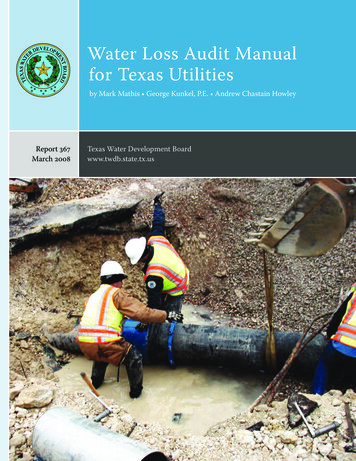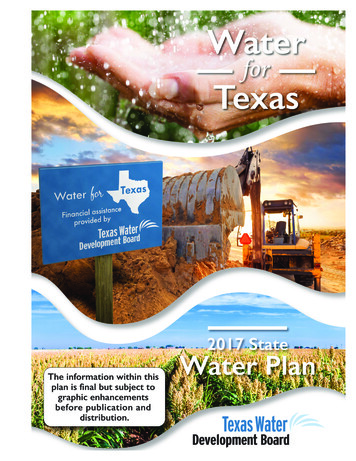
Transcription
1
Topics What is the Texas Water DevelopmentBoard (TWDB)? What financing tools do we offer? How can the TWDB help you?2
Texas has always been associated withopportunity, productivity, and growth.3
Texas has always been associated withopportunity, productivity, and growth.4
Texas has always been associated withopportunity, productivity, and growth.5
Our water resources are at the heart ofthat reputation.6
TWDB History is Texas History1822 Central Texas colonists led by Stephen F.Austin lose their initial food crops to drought and sometimestheyareinshortsupply. Settlers in West Texas return to the east after1884crops fail1956 Drought of Record: severe statewidedrought1957 Texas Water Development Board created;statewide water planning begins2011 Severe statewide drought returns7
TWDB History is Texas History1869 Bastrop evacuates as flood waters reach 46 feet1925 Flooding destroys 13 bridges and drowns 51people in San Antonio1935 Downtown Houston inundated by flooding ofthe Buffalo Bayou1949 Fort Worth flooded by the Trinity River, causing 10M in damage and killing 10 people1952 Flooding in Central Texas kills 5 and destroys17 homes2015 Blanco River rises 36ft in a few hours, washingaway entire residential blocks in Wimberley8
A Toolbox for Public Water UtilitiesThe legislature has entrusted the TWDB with a set of financingEach tool is unique, and some are designed for special purposes.tools to help public utilities achieve their infrastructure goals.Right-sizingProjects serving EconomicallyRural ProjectsDistressed Areasprojects for future demand9
A Toolbox for Public Water UtilitiesAgricultural Water Conservation Loans/Grants (AG)Clean Water State Revolving Fund (CWSRF)Drinking Water State Revolving Fund (DWSRF)Economically Distressed Areas Program (EDAP)Rural Water Assistance Fund (RWAF)State Participation Program (SP)State Water Implementation Fund for Texas (SWIFT)Texas Water Development Fund (DFund)10
How Can These Tools Work for You?AAA Bond RatingFunding to accommodateprojects of all sizesSome projects qualify forcombined funding throughmultiple programsAll project phases are eligible forfunding11
Eligible profit watersupply nd
Eligible ProjectsSWIFTCWSRFDWSRFWater Supply –Current NeedWater Supply –Future NeedWater TreatmentWater Transmission &DistributionPotable ReuseWastewater CollectionWastewater TreatmentNonpoint SourcePollution ControlFlood Control/StormwaterManagement13EDAPRWAFSPDFund
State Revolving Fund (SRF) Programs Partially funded by the U.S. EnvironmentalProtection Agency (EPA) Subsidized financing Partial principal forgiveness available for certainproject types Multi-year commitment option14
Drinking Water State Revolving Fund(DWSRF)Offers financing 125 basis points below theapplicant’s market interest rateRepayment terms up to 30 yearsPartial principal forgiveness available for DisadvantagedCommunities, Very Small Systems, Urgent Needprojects, and projects with green components15
Sample DWSRF ProjectStamfordWater System Improvements 1950s-era treatment plant needsimprovementsStamford Replacing 15 miles of 18” pipe toaddress water loss Replacement of WWII-era elevated storagetank Disadvantaged: 9,282,728 principal forgiveness Green project: 952,980 principal forgiveness 19,765,708 total DWSRF loan Cost savings: 18,807,93216
Clean Water State Revolving Fund(CWSRF)Offers financing up to 155 basis points below theapplicant’s market interest rateRepayment terms up to 30 yearsPartial principal forgiveness available forDisadvantaged Communities and projects withgreen components17
Sample CWSRF ProjectHoustonCollection System Rehabilitation Ongoing effort to renew at least600,000 linear feet of collectionHoustonsystem each year Pipe sizes range from 6” to 72” Project will reduce sanitary sewer overflows Inflow and infiltration are addressed, resulting inoptimized performance 65,750,000 total CWSRF loan Cost savings: 19,499,24218
SRF Annual Funding CycleProject solicitation(Project InformationForms submitted)TWDB and TCEQscore projectsTWDB publishesdraft Intended UsePlan (IUP)IUP finalized andapprovedTWDB invitesentities from the IUPto apply forfinancingDUE 03/03/2017IUP open for publicreview andcommentTWDB reviewsapplications andmakes fundingcommitmentsBorrowers close onloans19Or apply any timethroughout theyear if not seekingprincipalforgiveness
Primary SRF ProgramRequirements Disadvantaged Business Enterprise(DBE) procurement Environmental review Davis-Bacon prevailing wage rates American Iron & SteelTechnical assistance available!20
State-Funded Programs Funded with bond proceeds (AAA bondrating) Loans based on TWDB’s cost of funds Grants available (EDAP) Subsidization and deferral available (SWIFT)21
Eligible Projects Recommended water managementstrategies in the state water plan Includes a wide range of water supply andconservation projectsFinancing Options Low-interest loans Deferred loans Board Participation Multi-year commitments22
New for 2017 Low-interest loan interest rate subsidies specifiedfor taxable financing and rural entities Rural: communities with population of 10,000 orfewer, not located within the extraterritorialjurisdiction of any city with population of500,000 or greater.23
SWIFT Funding CycleRegional waterplansSubmit AbridgedApplicationDue 02/03/2017Application reviewand fundingcommitmentsTWDB staff performprioritization &capacity modelingState water planInvitation tosubmit fullapplications24Applicants closeon loans
Sample SWIFT ProjectAustinDirect Reuse Supply needs identified in regionalplanning will be met by increasedAustinconservation and expanded use ofreclaimed water Rehab and expansion of filtration systems,new storage tank and pump stations, andapproximately 74,000 feet of transmission mains 86,900,000 SWIFT multi-year commitment Cost savings: 2,035,348! (on 20 million closed in2016)25
SWIFT is the only state-fundedprogram with an applicationdeadline. Applications for theother state programs areaccepted at any time.26
EDAP assists projects in areas where: Income is not greater than 75% of statewide median Infrastructure is substandard or doesn’t exist Model Subdivision Rules (MSRs) are in place toprevent further substandard development27
EDAP Offers Grants Grant/loan ratio depends on projectphase and affordability calculation Nuisance determination required for 50% grant Popular program current bondingcapacity has been met28
Sample EDAP ProjectEast Aldine ManagementDistrictSherwood and Benton Place Water and Sewer First-time water & wastewater serviceto two areasEast Aldine District Documented 50% failure rate onprivate septic systems Small lot size means shallow water wellsare less than 50 ft. from septic drainage DSHS Nuisance Determination 10,912,331 total EDAP assistance 10,335,331 grant!29
Ag Conservation Loans Projects that improve irrigationefficiency Purchase and installation of devicesto measure use of irrigation water Technical assistance programs Research, demonstration, technologytransfer, or educational programs and more30
Sample Ag Conservation Loan ProjectPanhandle GroundwaterConservation District TWDB financing allows theDistrict to make loans toindividual farmers for moreefficient irrigation systems 2,000,000 loan Cost savings: 206,47531Panhandle GWCD
Ag Conservation GrantsAccepting applications now!(Due Feb. 15) Capacity: up to 200,000 per project Water use monitoring equipment,demonstration and technology transfer,irrigation efficiency studies Cameron.Turner@twdb.texas.gov32
Flood Protection Grant ProgramsFlood Protection Planning Grants to conduct feasibility studies for structural and nonstructural solutions to flood hazards in an entire watershedFlood Mitigation Assistance Federal funding for cost-effective measures to reduce oreliminate long-term flooding riskSevere Repetitive Loss Federal funding to assist implementation of mitigationmeasures to reduce or eliminate long-term risk33
Primary State ProgramRequirements Water conservation and droughtcontingency plans Environmental review U.S. Iron & Steel (except SWIFT) Water loss threshold requirements34
Other TWDB ResourcesProjectFinancingData WaterWastewaterFlood controlNonpointsourcepollutioncontrol Mapping andGIS Demographics Flood data InteractiveState WaterPlanSciencePlanning35 Groundwateravailability Environmentalflows Lake surveys Conservation Innovativetechnologies TexMesonet(weather data) State waterplan Water UseSurveys
Interactive State Water Plantexasstatewaterplan.orgClick anywhere above to visit texasstatewaterplan.org36
37
38
How to Get StartedCONTACT US!Team 1Panhandle/WestRegions: A/O/E/FLee Huntoon(512) 463-6021Team 2BrazosRegions: G/BCaarenSkrobarczyk(512) 475-1128Team 3NortheastRegions: C/DLuis Farias(512) 475-4816Team 4EastRegions: H/INancy Richards(512) 463-0250Team 5CentralRegions: J/K/L/PDain Larsen(512) 463-1618Team 6SouthRegions: M/NMireya Loewe(512) 475-059039
Pre-Application Meetings40
Thank You!Tom EntsmingerTWDB State Programs Coordinator(512) 936-0802Tom.Entsminger@twdb.texas.gov41
7 Central Texas colonists led by Stephen F. 1822 Austin lose their initial food crops to drought Settlers in West Texas return to the east after 1884 crops fail Drought of Record: severe statewide 1956 drought Texas Water Development Board created; 1957 statewide water planning begins 2011 Severe statewide drought returns and sometimes they are in short supply.










